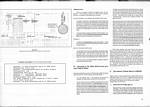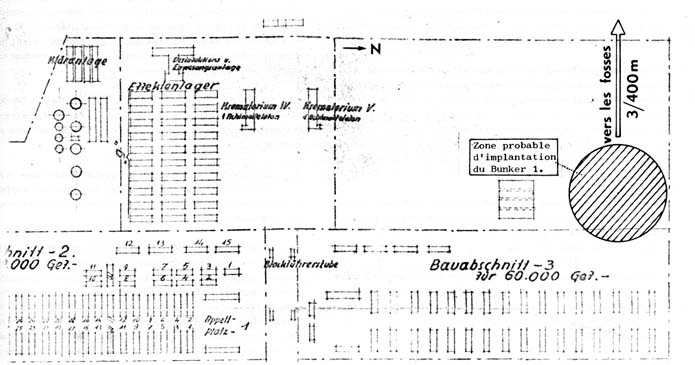|
|
 |
 |
AUSCHWITZ:
Technique
and Operation
of
the Gas Chambers © |
|
|
| |
 |
Back |
 |
Contents |
Page 163 |
 |
Home
Page |
Forward |
 |
| |
 |
|
Document 2:
Situation plan
showing the probable location of Bunker 1 and the mass graves |
| |
| |
Translation of
inscriptions
(from tap to bottom and left to right): |
|
| |
|
|
|
· |
Bauabschnitt 2
für 60,000 Gef /
Construction stage II, for 60,000
prisoners |
|
| · |
Kläranlage /
Sewage treatment plant |
|
| · |
Desinfektion u
Entwesungsanlage /
Disinfection and delousing installation |
|
| · |
Effektanlager /
Effects camp |
|
| · |
Appelplatz / Parade
ground [for roll calls] |
|
| · |
Krematorium IV
1 Achtmuffelofen / 1 eight muffle furnace |
|
| · |
Krematorium V
1 Achtmuffelofen / 1 eight muffle furnace |
|
| · |
Blockführerstube
/ Block leaders’ rooms |
|
| · |
Zone probable
d'implantation du Bunker 1 /
Probable area of location of Bunker 1
|
|
| · |
Vers les fosses / To
the mass graves |
|
| · |
Bauabschnitt 3 3
für 60,000 Gef /
Construction stage III, for 60,000 prisoners
|
|
|
| |
Additional details
I had a
conversation, recorded on magnetic tape, with Mr. Benroubi. These additional
details come either from his personal account, or in response to the questions
he was asked. Arrival at the Bunker 1 gas chambers and reception of the
victims: |
| |
“The children about 50 or 60 were holding
were holding hands in ranks of five and arrived at the Bunker accompanied by
about ten deportees in civilian clothes, glad to be with them The members of
the Sonderkommando greeted them kindly. Some people had babies in their arms
and the Sonderkommando helped them, advancing towards them some hundreds of
meters before the gas chamber with a friendly attitude, like when you receive
members of the family.”
“To give the deportees confidence
and the make them enter the showers, i.e., the gas chambers, quietly, the
Sonderkommando bandits were dressed in white and acted as if they belonged to
the hospital service.” |
| On Bunker 1: |
| |
“The Bunker was a brick built house, with
the windows filled in ... We had to turn our backs to the Bunker when we picked
up the corpses, never look at the gas chambers...” |
| And yet, if one dared a furtive glance:
|
| |
“Twenty meters from me, there was a door
still open, of the rolling or sliding type, and beyond it on one side a ground
floor door through which we could see shower heads. From the back no writing
was visible. The Sonderkommando took the people out of the gas chambers and
twenty meters away made them into separate piles of women, then children and
old men.”
“There was no odor around the gas chambers, nor the
graves, despite the trickles of fat that oozed out of
them.” |
| |
IV/ Declaration by Mr.
Milton BUKI
(former given names Majlech Michal) |
| |
| Declaration made before a notary on 15th
December 1980 n Jerusalem under reference No. 623/80. Extracts concerning
Bunker 1: |
| |
"On 10th December 1942, I ... was arrested by the
Germans and transported to Auschwitz where I arrived on the 12th of that
month…
The next morning at 5 o 'clock, an SS officer accompanied
by several men ordered us to go outside and took us to a brick farmhouse
on the edge of a wood. In front of this house there were about 40 corpses of
shot [?] men. We loaded these bodies onto trolleys mounted on narrow gauge
rails. The door of the house was then opened by an SS man. We saw that the
interior was full of corpses, some lying some standing and others hanging onto
one another. About twenty minutes or perhaps half an hour after the door was
opened, we were given the order to remove the bodies and load them on the on
the trolleys.
The bodies were all naked and some had blue stains
on them. We took the trolleys to a grave about 40 meters long and I think about
6 meters wide which was about 100 meters (actually 300 to 400] from the house.
Before the grave there was another group of deportees who threw the bodies into
the hole ... We learned that we formed part of a group called a
‘Sonderkommando’ whose job was to transport the bodies of the gassed
to the grave ..
While, on the first occasion, we were taken to the house
after the gassing had already taken place, later we were already there when the
convoy arrived. Under these conditions I was able to see the whole process. The
men, women and children were made to undress in a shed near the house. They
were then obliged to walk very quickly or even run between two ranks of SS who
had dogs. In this way they reached the open door of the house and went in. They
were told that it was simply a shower for disinfection purposes, after which
they would be admitted to the camp to work there under normal conditions. When
the interior of the house was absolutely full, the door was closed. Doctor
Mengele who was often [present] or another doctor replacing him, gave an SS man
the order to inject the gas. To do this he climbed several steps by the side
wall of the house and introduced through a little chimney [opening] the
contents of the can that he opened with a knife. About twenty minutes after the
injection of the gas the door was opened and the work of removing the bodies
commenced about half an hour afterwards. After being taken back to Block 11, we
could see the flames that consumed the bodies in the
grave..” |
| This witness certainly never knew that he had
worked at Bunker 1, but two details prove that he did: "a red brick cottage",
this is the red house and "a few steps" to climb for access to the opening
where the Zyklon B was introduced is a detail not reported by S. Dragon but
confirmed by his drawing. The witness speaks of one gas chamber and one access
door. Looking at the drawing of Bunker 1, it can be seen that an observer
situated below and to the left would be able to see only one door (D1) and only
one side opening for introducing the toxic gas (01). The gassing look place in
chamber K 1. The period, December 1942, indicated by the witness for his time
at Bunker 1 is correct. Before November 1942, the bodies were not incinerated,
afterwards they were. |
| |
| |
| V/ The testimony of Moshe
Maurice GARBARZ |
| |
| Written with his son Elie and published by
editions Plon in Paris in 1984 under the title "Un Survivant".
Trapped like Mr Benroubi, Mr Garbarz escaped from the work at from the work at
Bunker 1 in the same way its he did: through being detailed for the
Jawischowitz coalmine. [Extracts from "Un Survivant". |
| |
| (1) DEPARTURE FOR THE MINE [page 119]
|
| |
“By the seventh day, I had lost my last hope
of escaping, it was finished, I was trapped… In the evening, for some
unknown reason, we came back to the camp a little earlier. Perhaps our SS had a
lot of work and preferred to avoid leaving us hanging about over there. We had
hardly gone through the gate when the camp loudspeakers made an announcement:
|
|
|
AUSCHWITZ:
Technique and operation
of the gas
chambers
Jean-Claude Pressac
© 1989, The Beate Klarsfeld Foundation |
 |
Back |
Page 163 |
Forward |
 |
|

